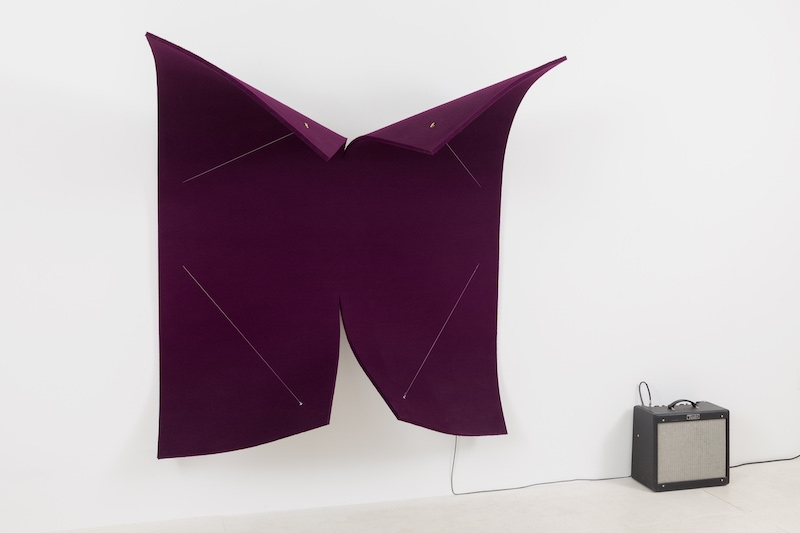Jonathan Griffin gets to grips with the tactile, mixed-media works from the installation and performance artist
I noticed no actual signage letting gallery visitors know that it was OK to touch certain of Naama Tsabar’s wall-mounted artworks. Fortunately, Israeli-born, New York-based Tsabar is becoming increasingly well known for her interactive Works on Felt series, begun in 2012: panels of thick felt, curling away from the wall (or, initially, the floor) under tension from taut piano wires. Those wires are connected to hidden microphones, which are in turn connected to cables that hang down and plug into nearby guitar amps. When struck – as a gallery director helpfully demonstrated, encouraging me to do the same – the wires produce a twang whose pitch can be modulated by flexing the felt. Stroking the felt creates a sound too. Four iterations of the series hang in this exhibition, variations (to use Tsabar’s terminology) 21 through 24.
The association with Robert Morris’s felt works of the late 1960s is unavoidable, and intentional. It is also somewhat unresolved, and ultimately a distraction from the many qualities that make these works compelling. My reading is that Morris features here as a kind of hypermasculine, authoritarian, antiexpressionistic straw man; he is one of a number of museum-grade Minimalists evoked by Tsabar (others include Ellsworth Kelly and Lucio Fontana) whose hegemony is supposedly undermined half a century after the fact by works that are tactile, interactive and feminised. (Tsabar uses female or gendernonconforming musicians when she activates her sculptures in performance – as she will towards the end of this exhibition.) To me, Morris – his bizarre 1974 Artforum ad notwithstanding – seems almost an antimacho artist: a pioneer of antiform and interactive sculptures, and a maker of entropic, defeated piles of floppy material. By contrast, Tsabar inserts carbon fibre inside her sheets of felt in order to maintain precisely the right semblance of flop, and public interaction with them is encouraged only under careful supervision.
Tsabar’s Transition works, a series begun in 2015, are based on deconstructed (though still functional) guitar amps. The kind of woven fabric that would usually cover the speaker is instead stretched over large paintinglike frames; these are inset with jacks, knobs, switches and blinking red LEDs and strung with electrical cables, giving the once-dudely hardware the appearance of looms. These pieces, apparently, are not meant to be touched, although other works by the artist can be plugged into them. When they are idle, they emit a low buzz – an ironic analogy, perhaps, of the crackling aura that emanates from certain Minimalist paintings by Agnes Martin, which one superficially resembles.
A new body of work, Inversions, features stringed instruments built into cavities in the gallery walls, implicitly transforming the entire building into a music-making device. In the sense that these esoteric sculptural interventions look like nothing so much as themselves, and do not rebound from preexisting artistic models or histories, they might be the most successful works in the show. Only the imperfect quality of their craftsmanship – which emulates guitar, harp, banjo and violin construction techniques – lets them down. (Luthiers set the bar pretty high.)
Inversions is also the title of the show. Maybe all art must declare what it is not – what it subverts, or inverts – before we understand what it is. I just wish that the art in this exhibition – which is undeniably strong both in form and in content – prioritised its own inherent generosity and sensuality, rather than foregrounding the precedents that it so obviously means to invert.
Naama Tsabar, Inversions, Shulamit Nazarian, Los Angeles, 10 January – 29 February 2020
From the March 2020 issue of ArtReview
